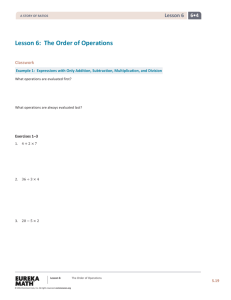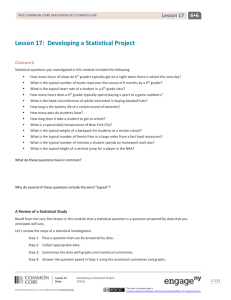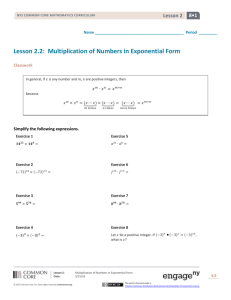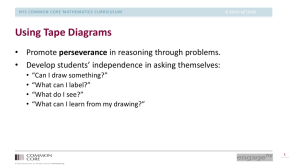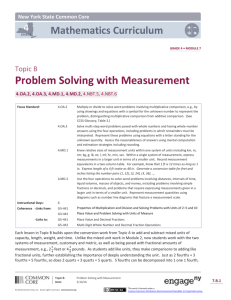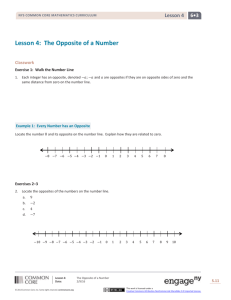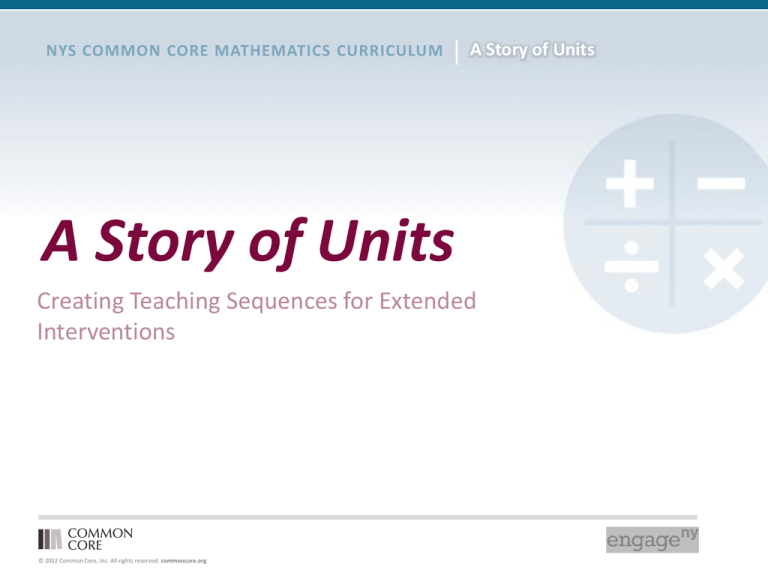
A Story of Units
A Story of Units
Creating Teaching Sequences for Extended
Interventions
© 2012 Common Core, Inc. All rights reserved. commoncore.org
U
Solve
6.
Z of Units
A Story
is 36 . of
is the intersection
7.
is the intersection of
is 125
.
© 2013 Common Core, Inc.
,
.
, and
.
° = _____
rights reserved. commoncore.org
Date:
A) 28 + 56 = ___
R
B) 17 × 25 = ___
and
10/16/13
symbol for the unknown angle measure.
Use the addition of adjacent angle measures to solve problems using a
Lesson 11:
T
V
S
125
Y
4.C.36
O
W
X
O
36
U
C) g°= ___
h°= ___
i°= ___
Z
is 36 .
is the intersection of
7.
R
T
125
O
,
, and
O
S
6.
° = __________
° =_________
V
is 125125
.
is the intersection of
is 125 .
is the intersection of
6.
° = _________
V
R
T
.
and
.
° = _________
° = __________
and
S
° = _________
.
° = _____
B
C
20
O
D
160
A
5.
© 2012 Common Core, Inc. All rights reserved. commoncore.org
is 160 and
is the intersection of
is 20
and
.
Write an equation and solve for the unknown angles numerically.
° = _________
B
° = __________
A Story of Units
Think of a sequence of problems.
• Step 1: Choose 1 of the problems: 28 + 56, 17 × 25, or the missing
angle problem.
• Step 2: Take 3 minutes to think of a sequence of few related math
problems that would lead like a “ladder” to your chosen problem.
• Step 3: Share your sequence of problems with a partner or larger
group.
• Step 4: Reflect on what you did to develop your sequence.
© 2012 Common Core, Inc. All rights reserved. commoncore.org
A Story of Units
Why do small and large sequences matter?
• Read, “Two Beliefs.”
• Use the following protocol: “Save the last word for me”
1.
2.
3.
4.
5.
Put a star to mark a statement from the reading that stands out to you
for whatever reason.
One member reads a starred statement.
The members of the triad (not the writer) comment on the statement.
Lastly, the person who chose the statement shares why the statement
was impactful.
Repeat the process with the other members of the group.
© 2012 Common Core, Inc. All rights reserved. commoncore.org
A Story of Units
Objective: Create an extended sequence for intervention.
•
Analyze incorrect student work and define the error by asking additional
questions.
•
Find and analyze coherent teaching sequences within A Story of Units to address
student knowledge gaps.
•
Use the coherence of A Story of Units
to plan an extended teaching
sequence for intervention.
•
Clarify a continuous cycle which allows
us to unify assessment, analysis,
planning, and teaching .
© 2012 Common Core, Inc. All rights reserved. commoncore.org
Assess
Teach
Analyze
Plan
A Story of Units
© 2012 Common Core, Inc. All rights reserved. commoncore.org
A Story of Units
Assess
Teach
Analyze
Plan
© 2012 Common Core, Inc. All rights reserved. commoncore.org
A Story of Units
Agenda
• Analyze student work using a protocol based on the Mathematical
Practices. Define the student error.
• Study and analyze foundational teaching sequences in A Story of Units
relevant to the assessment’s objective.
• Derive an extended teaching sequence to bridge the gap between the
student’s current level and the objective.
• Make an illustrated poster to share the sequence.
• Create “second chance” assessment questions.
• Professional Reading and Closure.
© 2012 Common Core, Inc. All rights reserved. commoncore.org
A Story of Units
Analyze the student work. Define the error(s).
© 2012 Common Core, Inc. All rights reserved. commoncore.org
A Story of Units
• What is the logic of the sequence, the “storyline”?
Another way of asking the same question:
• What are the “rungs” in the “ladder” to the objective
targeted by the assessment question?
• Does the student work reflect the work of the the module?
• What might that tell us about the student’s learning
experience?
© 2012 Common Core, Inc. All rights reserved. commoncore.org
A Story of Units
Analyze student work and the teaching sequence
within the assessment’s module.
Analyze student
work using the
Mathematical
Practices
Protocol.
© 2012 Common Core, Inc. All rights reserved. commoncore.org
Write questions
that will help
define both the
error(s) and the
last point of
success.
Read the
Module
Overview and
analyze the
Objective
Sequence of the
assessment
question.
Share the logic
of the module’s
sequence, its
ladder of
complexity, with
with your table
triads.
A Story of Units
• What is the logic of the sequence, the “storyline”?
Another way of asking the same question:
• What are the “rungs” in the “ladder” to the objective
targeted by the assessment question?
• Does the student work reflect the work of the the module?
• What might that tell us about the student’s learning
experience?
© 2012 Common Core, Inc. All rights reserved. commoncore.org
A Story of Units
Agenda
• Analyze student work using a protocol based on the Mathematical
Practice standards..
• Study and analyze foundational teaching sequences relevant to the
assessment’s objective.
• Develop and share an extended teaching sequence to bridge the gap
between the student’s current level and the objective.
• Make an illustrated poster to share the sequence.
• Create “second chance” assessment questions.
• Professional Reading and Closure.
© 2012 Common Core, Inc. All rights reserved. commoncore.org
A Story of Units
To find and analyze the teaching sequences before the
module, we must adeptly navigate in A Story of Units.
© 2012 Common Core, Inc. All rights reserved. commoncore.org
A Story of Units
Which modules are coherently linked to the objective?
© 2012 Common Core, Inc. All rights reserved. commoncore.org
A Story of Units
While studying, think about:
• the “rungs,” the logic of the sequence, the
“storyline”
• connections to and coherence with the grade level
objective.
• the lessons/instructional strategies you think will
most help the student.
© 2012 Common Core, Inc. All rights reserved. commoncore.org
A Story of Units
Analyze the relevant teaching sequences of
prior grade levels.
Analyze the
Curricular
Map and
Topic
Overview to
find what is
relevant to
meeting the
targeted
objective.
© 2012 Common Core, Inc. All rights reserved. commoncore.org
Read relevant
Module
Overviews
and analyze
the Objective
Sequences to
hone in on a
sequence for
your
intervention.
Research
within the
topics and
lessons to
investigate
teaching
sequences
more deeply.
Share your
learning
about the
teaching
sequences
with your
table triads.
A Story of Units
While studying, think about:
• the “rungs,” the logic of the sequence, the
“storyline.”
• connections to and coherence with the grade level
objective.
• the lessons/instructional strategies you think will
most help the student.
© 2012 Common Core, Inc. All rights reserved. commoncore.org
A Story of Units
Agenda
Collaboratively:
• Analyze student work using a protocol based on the Mathematical
Practice standards..
• Study and analyze foundational teaching sequences relevant to the
assessment’s objective.
• Develop and share an extended teaching sequence to bridge the gap
between the student’s current level and the objective.
• Make an illustrated poster to share the sequence.
• Create “second chance” assessment questions.
• Professional Reading and Closure.
© 2012 Common Core, Inc. All rights reserved. commoncore.org
A Story of Units
Build a ladder from the point of strength to the
objective.
© 2012 Common Core, Inc. All rights reserved. commoncore.org
A Story of Units
Plan your extended teaching sequence for
intervention.
Determine a starting
point for your triad’s
teaching sequence.
© 2012 Common Core, Inc. All rights reserved. commoncore.org
Plan and write a stepby-step first draft of
your teaching
sequence using the
decisions evidenced in
A Story of Units as
guidance
Share, critique and
tweak your sequence
with a grade-level-alike
group.
A Story of Units
Build a ladder from the point of strength to the
objective.
G2 M7 Topics C & E
Create a ruler.
Find missing units on a number line.
G3 M2 Topics A-C
The clock and the number line.
The graduated cylinder.
Unit form.
Rounding on the vertical number
line to the nearest 10 and 100.
G4 M1 Topics A –B
Number comparison in unit form
Rounding on the vertical number line.
© 2012 Common Core, Inc. All rights reserved. commoncore.org
A Story of Units
Agenda
• Analyze student work using a protocol based on the Mathematical
Practice standards..
• Study and analyze foundational teaching sequences relevant to the
assessment’s objective.
• Develop and share an extended teaching sequence to bridge the gap
between the student’s current level and the objective.
• Make an illustrated poster to share the sequence.
• Create “second chance” assessment questions.
• Professional Reading and Closure.
© 2012 Common Core, Inc. All rights reserved. commoncore.org
A Story of Units
Make a poster to
display the
extended
teaching
sequence.
© 2012 Common Core, Inc. All rights reserved. commoncore.org
A Story of Units
Note: For today, please stay within the curriculum’s lessons
rather than pulling from outside material or previously taught
lessons.
• Sketch a “concrete/pictorial/abstract” or “pictorial/abstract”
component at each step.
• Include the Grade Level, Module, and Lesson references for
each rung of the ladder.
• Briefly describe the logic of each step.
• Include the pacing of each step. (Suggestion: 20 minute
sessions with no more than 15 such sessions.)
© 2012 Common Core, Inc. All rights reserved. commoncore.org
A Story of Units
Agenda
• Analyze student work using a protocol based on the Mathematical
Practice standards..
• Study and analyze foundational teaching sequences relevant to the
assessment’s objective.
• Develop and share an extended teaching sequence to bridge the gap
between the student’s current level and the objective.
• Make an illustrated poster to share the sequence.
• Create “second chance” assessment questions.
• Professional Reading and Closure.
© 2012 Common Core, Inc. All rights reserved. commoncore.org
A Story of Units
Engage students in their own growth.
Write
assessment
questions for
different levels
of complexity of
your sequence.
© 2012 Common Core, Inc. All rights reserved. commoncore.org
Write “second
chance”
assessment
questions
analogous to
the original
question.
Plan ways to
involve
students in
their own data,
their own
progress
towards
specific
objectives.
Share your
assessment
questions with
other small
groups.
A Story of Units
Second Chance Assessments!
© 2012 Common Core, Inc. All rights reserved. commoncore.org
A Story of Units
Agenda
• Analyze student work using a protocol based on the Mathematical
Practice standards..
• Study and analyze foundational teaching sequences relevant to the
assessment’s objective.
• Develop and share an extended teaching sequence to bridge the gap
between the student’s current level and the objective.
• Make an illustrated poster to share the sequence.
• Create “second chance” assessment questions.
• Professional Reading and Closure.
© 2012 Common Core, Inc. All rights reserved. commoncore.org
A Story of Units
Reflection
How might “studying teaching materials” (zuanyan
jiaocai) be instrumental in educators becoming the
“taxi drivers” whose cabs we would want to catch
when late to the airport?
How might studying, creating, and sharing extended
teaching sequences support teachers in more deeply
understanding elementary mathematics?
© 2012 Common Core, Inc. All rights reserved. commoncore.org
A Story of Units
The Flow of our Work
© 2012 Common Core, Inc. All rights reserved. commoncore.org

